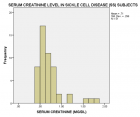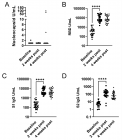Abstract
Research Article
Haemostasis with suture-tourniquet technique following removal of large-bore venous sheaths for endovascular recanalization of acute thrombosis in native arteriovenous fistula
Omur Balli*
Published: 26 August, 2019 | Volume 3 - Issue 3 | Pages: 010-013.
Purpose: To investigate the suture-tourniquet technique for haemostasis in patients with acute thrombosis of native arteriovenous fistula (AVF) whom underwent manual aspiration thrombectomy using large-bore venous sheaths and high dose heparin.
Methods: Between January 2016 and May 2018, patients with acute AVF thrombosis performed successful manual aspiration thrombectomy by using large bore venous sheaths and high dose heparin were included in this retrospective study. Success rate for haemostasis, procedural complications clinical and imaging follow up was reported descriptively.
Results: A total of 52 patients with 64 procedures met the inclusion criteria. In 60(94%) of 64 procedures, successful haemostasis was achieved with suture-tourniquet technique. In 2(3.1%) of the 64 procedures, the suture broke while turning the tourniquet and haematoma occurred in another 3 procedures (4.7%) although suture-tourniquet technique was applied appropriately. Manual compression was performed in these patients. There were 3 major complications unrelated the suture-tourniquet technique.
Conclusion: The suture tourniquet technique can achieve haemostasis rapidly and can be safely used with low complication rates without fistulae thrombosis after large-bore venous sheath removal following treatment of AVF thrombosis.
Read Full Article HTML DOI: 10.29328/journal.jro.1001029 Cite this Article Read Full Article PDF
Keywords:
Arteriovenous fistula; Manual aspiration thrombectomy; Haemostasis; Purse-string suture; Suture-tourniquet; Large bore venous sheath
References
- O’Reilly MK, Ryan D, Sugrue G, Geoghegan T, Lawler LP, et al. Novel Use of a Pneumatic Compression Device for Haemostasis of Haemodialysis Fistula Access Catheterisation Sites. Cardiovasc Intervent Radiol. 2016; 39:1765-1769. PubMed: https://www.ncbi.nlm.nih.gov/pubmed/27491405
- Dariushnia SR, Walker TG, Silberzweig JE, Annamalai G, Krishnamurthy V, et al. Quality Improvement Guidelines for Percutaneous Image-Guided Management of the Thrombosed or Dysfunctional Dialysis Circuit. J Vasc Interv Radiol. 2016; 27: 1518-1530. PubMed: https://www.ncbi.nlm.nih.gov/pubmed/27622727
- Zaleski GX, Funaki B, Gentile L, Garofalo RS. Purse-string sutures and miniature tourniquet to achieve immediate hemostasis of percutaneous grafts and fistulas: A simple trick with a twist. Am J Roentgenol. 2000; 175: 1643-1645.
- Vorwerk D, Konner K, Schürmann K, Günther RW. A simple trick to facilitate bleeding control after percutaneous hemodialysis fistula and graft interventions. Cardiovasc. Intervent. Radiol. 1997; 20: 159-160. PubMed: https://www.ncbi.nlm.nih.gov/pubmed/9030511
- Heras M, Pedro García-Cosmes P, Fernández-Reyes MJ, Sánchez R. Evolución natural de la función renal en el anciano: análisis de factores de mal pronóstico asociados a la enfermedad renal crónica. NEfrología. 2013; 33: 462-469.
- Simons ME, Rajan DK, Clark TWI. The Woggle technique for suture closure of hemodialysis access catheterization sites. J Vasc Interv Radiol. 2003; 14: 485-488. PubMed: https://www.ncbi.nlm.nih.gov/pubmed/12682206
- Uflacker R, Rajagopalan PR, Vujic I, Stutley JE. Treatment of thrombosed dialysis access grafts: Randomized trial of surgical thrombectomy versus mechanical thrombectomy with the amplatz device. J Vasc Interv Radiol. 1996; 7: 185-192. PubMed: https://www.ncbi.nlm.nih.gov/pubmed/9007796
- Barzel E. Use of a simple compression dressing to obtain hemostasis after pharmacologic thrombolysis of dialysis grafts. J Vasc Interv Radiol. 1999; 10: 1039-1042. PubMed: https://www.ncbi.nlm.nih.gov/pubmed/10496705
- Clark TWI, Haji-Momenian S, Kwak A, Soulen MC, Stavropoulos SW, et al. Angiographic Changes following the Use of a Purse-String Suture Hemostasis Device in Hemodialysis Access Interventions. J Vasc Interv Radiol. 2009; 20: 61-65. PubMed: https://www.ncbi.nlm.nih.gov/pubmed/19019702
- Quencer KB, Friedman T. Declotting the Thrombosed Access. Tech Vasc Interv Radiol. 2017; 20: 38-47. PubMed: https://www.ncbi.nlm.nih.gov/pubmed/28279408
- Doerflinger DMC. Normal changes of aging and their impact on care of the older surgical patient. Thorac Surg Clin. 2009; 19: 289-299. PubMed: https://www.ncbi.nlm.nih.gov/pubmed/20066941
Similar Articles
-
Haemostasis with suture-tourniquet technique following removal of large-bore venous sheaths for endovascular recanalization of acute thrombosis in native arteriovenous fistulaOmur Balli*. Haemostasis with suture-tourniquet technique following removal of large-bore venous sheaths for endovascular recanalization of acute thrombosis in native arteriovenous fistula. . 2019 doi: 10.29328/journal.jro.1001029; 3: 010-013.
Recently Viewed
-
Do Fishes Hallucinate Human Folks?Dinesh R*,Sherry Abraham,Kathiresan K,Susitharan V,Jeyapavithran C,Paul Nathaniel T,Siva Ganesh P. Do Fishes Hallucinate Human Folks?. Arch Food Nutr Sci. 2017: doi: 10.29328/journal.afns.1001003; 1: 020-023
-
Assessment of Redox Patterns at the Transcriptional and Systemic Levels in Newly Diagnosed Acute LeukemiaAna Carolina Agüero Aguilera, María Eugenia Mónaco, Sandra Lazarte, Emilse Ledesma Achem, Natalia Sofía Álvarez Asensio, Magdalena María Terán, Blanca Alicia Issé, Marcela Medina, Cecilia Haro*. Assessment of Redox Patterns at the Transcriptional and Systemic Levels in Newly Diagnosed Acute Leukemia. J Hematol Clin Res. 2024: doi: 10.29328/journal.jhcr.1001029; 8: 017-023
-
Assessment of Indigenous Knowledge on Using of Traditional Medicinal Plants to Cure Human Diseases in South Omo Zone Baka Dawla Ari District, Kure and Bitsmal South EthiopiaGizaw Bejigo*. Assessment of Indigenous Knowledge on Using of Traditional Medicinal Plants to Cure Human Diseases in South Omo Zone Baka Dawla Ari District, Kure and Bitsmal South Ethiopia. J Plant Sci Phytopathol. 2024: doi: 10.29328/journal.jpsp.1001132; 8: 048-054
-
Nanoencapsulated Extracts from Leaves of Bauhinia forficata Link: In vitro Antioxidant, Toxicogenetic, and Hypoglycemic Activity Effects in Streptozotocin-induced Diabetic MiceBárbara Verônica Cardoso de Souza, Alessandra Braga Ribeiro*, Rita de Cássia Meneses Oliveira, Julianne Viana Freire Portela, Ana Amélia de Carvalho Melo Cavalcante, Esmeralda Maria Lustosa Barros, Luís Felipe Lima Matos, Tarsia Giabardo Alves, Maria. Nanoencapsulated Extracts from Leaves of Bauhinia forficata Link: In vitro Antioxidant, Toxicogenetic, and Hypoglycemic Activity Effects in Streptozotocin-induced Diabetic Mice. Arch Pharm Pharma Sci. 2024: doi: 10.29328/journal.apps.1001063; 8: 100-115
-
GELS as Pharmaceutical Form in Hospital Galenic Practice: Chemico-physical and Pharmaceutical AspectsLuisetto M*,Edbey Kaled,Mashori GR,Ferraiuolo A,Fiazza C,Cabianca L,Latyschev OY. GELS as Pharmaceutical Form in Hospital Galenic Practice: Chemico-physical and Pharmaceutical Aspects. Arch Surg Clin Res. 2025: doi: 10.29328/journal.ascr.1001084; 9: 001-007
Most Viewed
-
Evaluation of Biostimulants Based on Recovered Protein Hydrolysates from Animal By-products as Plant Growth EnhancersH Pérez-Aguilar*, M Lacruz-Asaro, F Arán-Ais. Evaluation of Biostimulants Based on Recovered Protein Hydrolysates from Animal By-products as Plant Growth Enhancers. J Plant Sci Phytopathol. 2023 doi: 10.29328/journal.jpsp.1001104; 7: 042-047
-
Sinonasal Myxoma Extending into the Orbit in a 4-Year Old: A Case PresentationJulian A Purrinos*, Ramzi Younis. Sinonasal Myxoma Extending into the Orbit in a 4-Year Old: A Case Presentation. Arch Case Rep. 2024 doi: 10.29328/journal.acr.1001099; 8: 075-077
-
Feasibility study of magnetic sensing for detecting single-neuron action potentialsDenis Tonini,Kai Wu,Renata Saha,Jian-Ping Wang*. Feasibility study of magnetic sensing for detecting single-neuron action potentials. Ann Biomed Sci Eng. 2022 doi: 10.29328/journal.abse.1001018; 6: 019-029
-
Pediatric Dysgerminoma: Unveiling a Rare Ovarian TumorFaten Limaiem*, Khalil Saffar, Ahmed Halouani. Pediatric Dysgerminoma: Unveiling a Rare Ovarian Tumor. Arch Case Rep. 2024 doi: 10.29328/journal.acr.1001087; 8: 010-013
-
Physical activity can change the physiological and psychological circumstances during COVID-19 pandemic: A narrative reviewKhashayar Maroufi*. Physical activity can change the physiological and psychological circumstances during COVID-19 pandemic: A narrative review. J Sports Med Ther. 2021 doi: 10.29328/journal.jsmt.1001051; 6: 001-007

HSPI: We're glad you're here. Please click "create a new Query" if you are a new visitor to our website and need further information from us.
If you are already a member of our network and need to keep track of any developments regarding a question you have already submitted, click "take me to my Query."

















































































































































